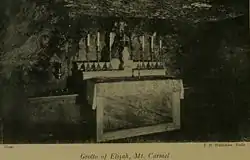Cave of Elijah
The Cave of Elijah is a grotto that appears in the Hebrew Bible, where the prophet Elijah took shelter during a journey into the wilderness (1 Kings 19:8).[1]

The exact location of the cave is unknown. There is a "Cave of Elijah" on Mount Carmel approximately 40 m above sea level in Haifa. For centuries it has been a pilgrimage destination for Jewish, Christian and Muslim people. Another cave associated with Elijah is located nearby, under the altar of the main church of the Stella Maris Monastery, also on Mount Carmel.[2][3]
The name of the cave is also known as el-Khader in Arabic[3]
Biblical story
In the Books of Kings the old testament prophet Elijah takes shelter in a cave on Mount Horeb after traveling for 40 days and 40 nights. Upon awakening, he is spoken to by God.
Before an assembly on the summit of Mount Carmel, Elijah calls on the priests to seek fire from their god Baal to light a sacrifice. When Baal fails to respond to their pleading, Elijah rebuilds the ruined altar of the Lord and offers his own sacrifice. Immediately, fire from heaven consumes the offering, even though it had been soaked in water.[4][5][6]
Historical sources
“The Cave of Elijah” has been presented primarily as part of Mount Carmel in the works of travelers, historians, pilgrims and other visitors.[3]
The Pilgrim of Bordeaux who visited Mount Carmel didn't mention in his notes about the cave, but describes it as: “… there is Mount Carmel, there Elijah sacrificed …”[3]
Ioannes Phokas, a pilgrim who supposedly went to the cave in 1185 writes: "… After these (places) there is Mt. Carmel, … At the end of the ridge of Mt. Carmel facing the sea, there is the cave of the Prophet Elijah, …"[3]
A Jewish pilgrim who supposedly visited the cave during the period between 1270 and 1291 claimed: “There on the slopes of Mt. Carmel is a cave, and there the synagogue dedicated to Elijah, be he remembered for good. Above the cave, on the top of the mountain, there is Elisha’s Cave."[3]
An English prelate and traveller Richard Pococke wrote in his notes in 1738 that Elijah had lived and worshipped in the prayer hall of the cave, and that the site was admired by Christians, Jews and Muslims, and that it was visited on Elijah's birthday. Pococke indicated that visiting the cave on the Saturday after Sabbath of Consolation had become a custom.[3]
References
- "Elijah's Cave | Haifa, Israel Attractions". Lonely Planet. Retrieved 2020-09-15.
- "Stella Maris". Goisrael.com. Archived from the original on 2016-10-05. Retrieved 2016-12-14.
- "Elijah's Cave on Mount Carmel and its Inscriptions" (PDF).
- Laiklock, E. M.: Eight Days in Israel (Ark Publishing, 1980)
- Brownrigg, Ronald: Come, See the Place: A Pilgrim Guide to the Holy Land (Hodder and Stoughton, 1985)
- Freeman-Grenville, G. S. P.: The Holy Land: A Pilgrim’s Guide to Israel, Jordan and the Sinai (Continuum Publishing, 1996)
